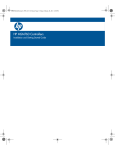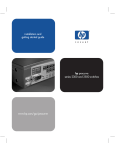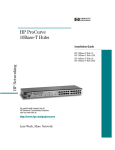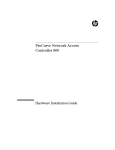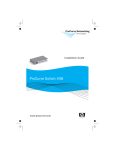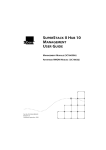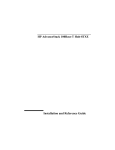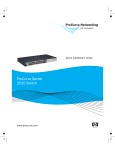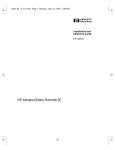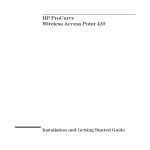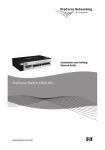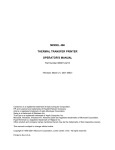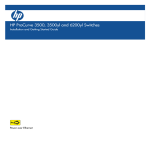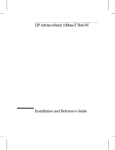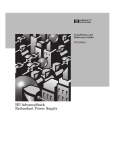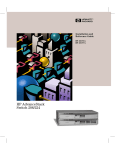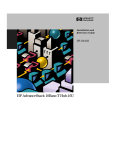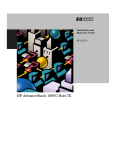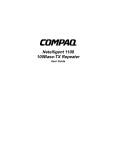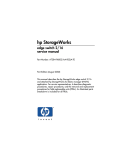Download HP 12M Installation Manual
Transcript
HP ProCurve Switches and Hubs HP ProCurve 10/100 Hubs Installation Guide L e s s Wo r k , M o r e N e t w o r k http://www.hp.com/go/procurve 9934.book Page i Thursday, January 14, 1999 12:39 PM HP ProCurve 10/100 Hubs Installation Guide 9934.book Page ii Thursday, January 14, 1999 12:39 PM © Copyright 1999 Hewlett-Packard Company All Rights Reserved. This document contains information which is protected by copyright. Reproduction, adaptation, or translation without prior permission is prohibited, except as allowed under the copyright laws. Publication Number 5967-9934 January 1999 Disclaimer The information contained in this document is subject to change without notice. HEWLETT-PACKARD COMPANY MAKES NO WARRANTY OF ANY KIND WITH REGARD TO THIS MATERIAL, INCLUDING, BUT NOT LIMITED TO, THE IMPLIED WARRANTIES OF MERCHANTABILITY AND FITNESS FOR A PARTICULAR PURPOSE. Hewlett-Packard shall not be liable for errors contained herein or for incidental or consequential damages in connection with the furnishing, performance, or use of this material. Applicable Products Hewlett-Packard assumes no responsibility for the use or reliability of its software on equipment that is not furnished by Hewlett-Packard. HP ProCurve 10/100 Hub 12 (HP J3294A) HP ProCurve 10/100 Hub 24 (HP J3295A) HP ProCurve 10/100 Hub 12M (HP J3288A) HP ProCurve 10/100 Hub 24M (HP J3289A) Warranty See the Customer Support/Warranty booklet included with the product. A copy of the specific warranty terms applicable to your Hewlett-Packard products and replacement parts can be obtained from your HP Sales and Service Office or authorized dealer. Safety Before installing and operating these products, please read the “Installation Precautions” in chapter 2, “Installing the HP 10/100 Hubs”, and the safety statements in appendix C, “Safety and EMC Regulatory Statements”. Hewlett-Packard Company 8000 Foothills Boulevard, m/s 5552 Roseville, California 95747-5552 http://www.hp.com/go/procurve 9934.book Page iii Thursday, January 14, 1999 12:39 PM Contents 1 Introducing the HP ProCurve 10/100 Hubs Front of the Hubs . . . . . . . . . . . . . . . . . . . . . . . . . . . . . . . . . . . . . . . . . . . . . 1-2 Network Ports . . . . . . . . . . . . . . . . . . . . . . . . . . . . . . . . . . . . . . . . . . . . . . 1-3 Port LEDs . . . . . . . . . . . . . . . . . . . . . . . . . . . . . . . . . . . . . . . . . . . . . . . . . . 1-3 LEDs for the 10/100Base-T Hubs . . . . . . . . . . . . . . . . . . . . . . . . . . . . . . . 1-4 Console Port (Hub 12M and Hub 24M) . . . . . . . . . . . . . . . . . . . . . . . . . . 1-5 Reset Button . . . . . . . . . . . . . . . . . . . . . . . . . . . . . . . . . . . . . . . . . . . . . . . 1-5 Clear Button (Hub 12M and Hub 24M) . . . . . . . . . . . . . . . . . . . . . . . . . . 1-5 Back of the Hubs . . . . . . . . . . . . . . . . . . . . . . . . . . . . . . . . . . . . . . . . . . . . . . 1-5 Power Connector . . . . . . . . . . . . . . . . . . . . . . . . . . . . . . . . . . . . . . . . . . . 1-5 Features . . . . . . . . . . . . . . . . . . . . . . . . . . . . . . . . . . . . . . . . . . . . . . . . . . . . . . 1-6 2 Installing the HP 10/100 Hubs Included Parts . . . . . . . . . . . . . . . . . . . . . . . . . . . . . . . . . . . . . . . . . . . . . . . . 2-1 Installation Procedures . . . . . . . . . . . . . . . . . . . . . . . . . . . . . . . . . . . . . . . . 2-2 Summary . . . . . . . . . . . . . . . . . . . . . . . . . . . . . . . . . . . . . . . . . . . . . . . . . . . 2-2 Installation Precautions . . . . . . . . . . . . . . . . . . . . . . . . . . . . . . . . . . . . . . 2-3 1. Prepare the Installation Site . . . . . . . . . . . . . . . . . . . . . . . . . . . . . . . . 2-4 2. Verify the Hub Passes Its Self Test . . . . . . . . . . . . . . . . . . . . . . . . . . . 2-5 LED Behavior: . . . . . . . . . . . . . . . . . . . . . . . . . . . . . . . . . . . . . . . . . . 2-5 3. Mount the Hub . . . . . . . . . . . . . . . . . . . . . . . . . . . . . . . . . . . . . . . . . . . . Rack or Cabinet Mounting . . . . . . . . . . . . . . . . . . . . . . . . . . . . . . . . Horizontal Surface Mounting . . . . . . . . . . . . . . . . . . . . . . . . . . . . . . Wall Mounting . . . . . . . . . . . . . . . . . . . . . . . . . . . . . . . . . . . . . . . . . . . 2-6 2-6 2-8 2-9 4. Connect the Hub to a Power Source . . . . . . . . . . . . . . . . . . . . . . . . . . 2-9 5. Connect the Network Cables . . . . . . . . . . . . . . . . . . . . . . . . . . . . . . . 2-10 6. (Optional) Connect a Console to the Hub (Hub 12M and Hub 24M only) . . . . . . . . . . . . . . . . . . . . . . . . . . . . . . . Terminal Configuration . . . . . . . . . . . . . . . . . . . . . . . . . . . . . . . . . . Direct Console Access . . . . . . . . . . . . . . . . . . . . . . . . . . . . . . . . . . . Telnet Console Access . . . . . . . . . . . . . . . . . . . . . . . . . . . . . . . . . . 2-11 2-11 2-12 2-12 iii 9934.book Page iv Thursday, January 14, 1999 12:39 PM Sample Network Topologies . . . . . . . . . . . . . . . . . . . . . . . . . . . . . . . . . . 2-13 Connecting End Nodes to HP 10/100 Hubs . . . . . . . . . . . . . . . . . . . . . 2-13 Cascading HP 10/100 Hubs – 10Base-T Networks . . . . . . . . . . . . . . . . 2-14 Cascading HP 10/100 Hubs – 100Base-TX Networks . . . . . . . . . . . . . 2-15 Cascading HP 10/100 Hubs – 10 and 100 Mbps . . . . . . . . . . . . . . . . . . 2-16 Connecting HP 10/100 Hubs to Switches . . . . . . . . . . . . . . . . . . . . . . . 2-17 Where to Go From Here . . . . . . . . . . . . . . . . . . . . . . . . . . . . . . . . . . . . . . 2-18 3 Troubleshooting Basic Troubleshooting Tips . . . . . . . . . . . . . . . . . . . . . . . . . . . . . . . . . . . . 3-2 Diagnosing with the LEDs . . . . . . . . . . . . . . . . . . . . . . . . . . . . . . . . . . . . . 3-4 Proactive Networking . . . . . . . . . . . . . . . . . . . . . . . . . . . . . . . . . . . . . . . . . 3-6 Hardware Diagnostic Tests . . . . . . . . . . . . . . . . . . . . . . . . . . . . . . . . . . . . 3-7 Testing the Hub by Resetting It . . . . . . . . . . . . . . . . . . . . . . . . . . . . . . . . 3-7 Testing Twisted-Pair Cabling . . . . . . . . . . . . . . . . . . . . . . . . . . . . . . . . . . 3-7 Testing Hub-to-Device Network Communications (Hub 12M and Hub 24M only) . . . . . . . . . . . . . . . . . . . . . . . . . . . . . . . . 3-8 Testing End-to-End Network Communications . . . . . . . . . . . . . . . . . . 3-8 HP Customer Support Services . . . . . . . . . . . . . . . . . . . . . . . . . . . . . . . . . 3-9 A Specifications Physical . . . . . . . . . . . . . . . . . . . . . . . . . . . . . . . . . . . . . . . . . . . . . . . . . A-1 Electrical . . . . . . . . . . . . . . . . . . . . . . . . . . . . . . . . . . . . . . . . . . . . . . . . . A-1 Environmental . . . . . . . . . . . . . . . . . . . . . . . . . . . . . . . . . . . . . . . . . . . . . A-1 Acoustic . . . . . . . . . . . . . . . . . . . . . . . . . . . . . . . . . . . . . . . . . . . . . . . . . . A-2 Connectors . . . . . . . . . . . . . . . . . . . . . . . . . . . . . . . . . . . . . . . . . . . . . . . . A-2 Safety . . . . . . . . . . . . . . . . . . . . . . . . . . . . . . . . . . . . . . . . . . . . . . . . . . . . A-2 iv 9934.book Page v Thursday, January 14, 1999 12:39 PM B Cables and Connectors Twisted-Pair Cable/Connector Pin-Outs . . . . . . . . . . . . . . . . . . . . . . . B-1 Twisted-Pair Cable for Hub (MDI-X) to Computer (MDI) 10 Mbps or 100 Mbps Network Connection . . . . . . B-2 Twisted-Pair Cable for Hub (MDI-X) to Hub (MDI-X) 10 Mbps or 100 Mbps Network Connection . . . . . . . . . B-3 Twisted-Pair Cable Pin Assignments . . . . . . . . . . . . . . . . . . . . . . . . . . B-4 Twisted-Pair Straight-Through Cable . . . . . . . . . . . . . . . . . . . . . . B-4 Twisted-Pair Crossover Cable . . . . . . . . . . . . . . . . . . . . . . . . . . . . B-4 C Safety and EMC Regulatory Statements Safety Information . . . . . . . . . . . . . . . . . . . . . . . . . . . . . . . . . . . . . . . . . . . C-1 EMC Regulatory Statements . . . . . . . . . . . . . . . . . . . . . . . . . . . . . . . . . . C-8 Index v 9934.book Page vi Thursday, January 14, 1999 12:39 PM 9934.book Page 1 Thursday, January 14, 1999 12:39 PM 1 The HP ProCurve 10/100 hubs are low-cost multiport, dual-speed (10- and 100Mbps) repeaters that can be used to build high-performance workgroup networks. These hubs are autosensing and autonegotiating devices that provide the flexibility of adjusting to different network connection speed settings. The hub ports always operate at half-duplex. There are four hub models. Two are managed: ■ HP ProCurve 10/100 Hub 12M (HP J3288A) ■ HP ProCurve 10/100 Hub 24M (HP J3289A) and two are unmanaged: ■ HP ProCurve 10/100 Hub 12 (HP J3294A) ■ HP ProCurve 10/100 Hub 24 (HP J3295A) Throughout this manual, these hubs will be abbreviated as the HP 10/100 hubs, or they may be described as the Hub 12, Hub 24, Hub 12M, and Hub 24M. With these hubs you can build a network infrastructure by connecting the hubs to other hubs, switches, or routers, or you can directly connect computers, printers, and servers to these hubs to provide shared 10- or 100-Mbps bandwidth to those devices. This chapter describes your HP 10/100 hubs: ■ Front and back of the hubs ■ Network Ports ■ Port and Hub LEDs ■ Features ■ Hub operation overview 1-1 Introducing the HP ProCurve 10/100 Hubs Introducing the HP ProCurve 10/100 Hubs 9934.book Page 2 Thursday, January 14, 1999 12:39 PM Introducing the HP ProCurve 10/100 Hubs Introducing the HP ProCurve 10/100 Hubs Front of the Hubs Front of the Hubs These illustrations show the Hub 24 and Hub 24M. The Hub 12 and Hub 12M have the same physical characteristics with 12 fewer 10/100 ports. 10/100Base-T RJ-45 ports Port LEDs Power LED HP ProCurve 10/100 Hub 24 Fault LED Reset button Collision LED MDI/MDI-X Button for Port 1 Activity LED HP ProCurve 10/100 Hub 24M Console Port (Hub 12M and 24M only) 1-2 Clear Button (Hub 12M and 24M only) 9934.book Page 3 Thursday, January 14, 1999 12:39 PM Introducing the HP ProCurve 10/100 Hubs Front of the Hubs The HP 10/100 hubs have 12 or 24 RJ-45 ports that can be used for either 10Base-T or 100Base-TX connections. Ports 2 through 12 or 24 are wired as MDI-X. Therefore, to connect end nodes or other MDI-type devices to these ports, use “straight-through” twisted-pair cable; to connect hubs, switches, or other MDI-X-type devices to these ports, use “crossover” twisted-pair cable. See Appendix B, “Cables and Connectors” for descriptions of these cables. Port 1 can operate as either an MDI-X or MDI port, controlled by the MDI-X/ MDI button on the front of the hub. If you have only straight-through cable, you can use Port 1 with the button in the MDI position to connect the hub to switches, other hubs, and other MDI-X devices. In the MDI position, the button crosses the cable pairs on Port 1 so that the Transmit and Receive pins on connecting devices exchange signals correctly when using straight-through cable. With the button in the MDI-X position, Port 1 operates the same as the other ports. Port LEDs For each network port on the hub, there are two LEDs: Link. This LED highlights the port number, and when lit, indicates the port has detected a valid link with a connected device. 100. This LED when lit, indicates that the port is connected to an attached device operating at 100 Mbps. If the 100 LED is not lit, and the Link LED indicates a valid connection, then the port is operating at 10 Mbps. See the following sections for more details on the LEDs. Link LED. Indicates whether the port has detected the link beat signal from an attached device. 100 LED. Indicates whether the associated port is operating at 100 Mbps. If the 100 LED is not lit, then the port is operating at 10 Mbps 1-3 Introducing the HP ProCurve 10/100 Hubs Network Ports 9934.book Page 4 Thursday, January 14, 1999 12:39 PM Introducing the HP ProCurve 10/100 Hubs Front of the Hubs Introducing the HP ProCurve 10/100 Hubs LEDs for the 10/100Base-T Hubs The following table describes the hub’s LED displays. Hub Status LED State Meaning Power (Green) The hub is receiving power. Fault (Orange) Act (activity Green) Col (collision Orange) On Off The hub is NOT receiving power. Off The normal state. Indicates that there are no fault conditions on the hub. On The hub is in self test after being powered on or reset. If on for a prolonged time, the hub has failed its self test. See “Diagnosing with the LEDs” in chapter 3, “Troubleshooting” for more information. On/ Flickering The hub is receiving packets on at least one of its ports. If it appears to be on continuously, network traffic is excessive. Off The hub is not receiving packets from any attached device. On/ Flickering A network collision has been detected on any of the hub ports. If the LED is on solid, a heavy collision rate is occurring. Off Collisions are not occurring on the network. On The port detects an attached device. Off The port has not detected another device. Link LEDs Link Slow Blink* The port has been autopartitioned due to excessive collisions. Fast Blink† A security violation has been detected on the port (Hub 12M and Hub 24M only) * The slow blink behavior is a regular pulse, once every 1.6 seconds, approximately. † The fast blink behavior is a regular pulse, once every 0.8 seconds, approximately. 100 LEDs 100 Mbps Indicator LED 1-4 On The port is operating at 100 Mbps. Off The port is operating at 10 Mbps. (This LED is meaningful only if the Link LED is lit for the port.) 9934.book Page 5 Thursday, January 14, 1999 12:39 PM Introducing the HP ProCurve 10/100 Hubs Back of the Hubs Console Port (Hub 12M and Hub 24M) Reset Button This button is used to reset the hub while it is powered on. This action clears any temporary error conditions that may have occurred, restarts the hub and executes the hub self test. A typical instance of where you might use the Reset button is in the event of a hub malfunction or error condition. Clear Button (Hub 12M and Hub 24M) This button is used for deleting any hub console and web browser interface passwords that you have configured for the hub. When pressed for at least ten seconds, the button deletes the passwords. Use this feature if you have misplaced the password and need console access. Note This button is provided for your convenience, but its presence means that if you are concerned with the security of the hub configuration and operation, you should make sure the hub is installed in a secure location, such as a locked wiring closet. Back of the Hubs Power Connector The 10/100 hubs do not have a power switch; they are powered on when connected to an active AC power source. The hubs automatically adjust to various voltages (depending on the country) between 100-127 and 200-240 volts and either 50 or 60 Hz. There are no voltage range settings required. AC Power Connector Cooling vents - make sure these are not obstructed for proper hub operation 1-5 Introducing the HP ProCurve 10/100 Hubs This port is used to connect a console to the hub by using the serial cable supplied with the hub. This connection is described under “connect a Console to the Hub” in chapter 2, “Installing the 10/100 Hubs”. The console can be a PC or workstation running an ASCII (TTY) or VT-100 terminal emulator, or an actual ASCII or VT-100 terminal. 9934.book Page 6 Thursday, January 14, 1999 12:39 PM Introducing the HP ProCurve 10/100 Hubs Introducing the HP ProCurve 10/100 Hubs Features Features The features of the HP ProCurve 10/100 hubs include: 1-6 ■ 12 or 24 Ethernet 10/100Base-T ports with RJ-45 connectors ■ plug-and-play networking—all ports are enabled—just connect the network cables to active Ethernet or Fast Ethernet network devices and your network is operational ■ all ports can autonegotiate the connection speed (10 or 100 Mbps) with the connected device ■ a built-in bridge connects 10 Mbps and 100 Mbps devices automatically, with nothing else to buy ■ per port LEDs showing link status and whether the port is operating at 100 Mbps or 10 Mbps ■ Activity and Collision LEDs showing general levels of network activity and collisions on the hub ■ push-button MDI/MDI-X selection on Port 1 to allow a straight-through cable to be used for cascading to another hub or switch ■ rack- or wall-mountable with mounting hardware included ■ additional management features such as per-port security, and hub control through a full-featured hub console, through the built-in web browser interface, and through HP TopTools for Hubs & Switches is available for the Hub 12M and Hub 24M 9934.book Page 1 Thursday, January 14, 1999 12:39 PM 2 Installing the HP 10/100 Hubs The HP 10/100 hubs are easy-to-install. Each comes with an accessory kit that includes the brackets for mounting the hub in a standard 19-inch telco rack or equipment cabinet, or on a wall, and also includes rubber feet that can be attached to the hub so it can be securely located on a horizontal surface. The brackets are designed to allow mounting the hubs in a variety of orientations. Included Parts The HP 10/100 hubs have the following components shipped with them: ■ HP ProCurve 10/100 Hubs Installation Guide (5967-9934), this manual ■ Connectivity Rules for 100T Networks (5967-2281) ■ HP ProCurve 10/100 Hub 12M and Hub 24M Management and Configuration Guide (5967-9933) -- for Hub 12M and Hub 24M only ■ HP TopTools for Hub & Switches - CD-ROM and booklet -- for Hub 12M and Hub 24M only ■ Customer Support/Warranty booklet ■ Accessory kit (5064-2085): • two mounting brackets • four 8 mm M4 screws to attach the mounting brackets to the hub • four 5/8-inch number 12-24 screws to attach the brackets to a rack • four rubber feet ■ Console cable -- Hub 12M and Hub 24M only ■ Power cord, one of the following: Australia/New Zealand China Continental Europe Denmark Japan Switzerland United Kingdom/Hong Kong/Singapore United States/Canada/Mexico 8120-6803 8120-8377 8120-6802 8120-6806 8120-6804 8120-6807 8120-8709 8120-6805 2-1 Installing the HP 10/100 Hubs This chapter shows you how to install your HP 10/100 hub. 9934.book Page 2 Thursday, January 14, 1999 12:39 PM Installing the HP 10/100 Hubs Installation Procedures Installation Procedures Summary Installing the HP 10/100 Hubs Follow these easy steps to install your hub. The rest of this chapter provides details on these steps. 1. Prepare the installation site (page 2-4). Make sure that the physical environment into which you will be installing the hub is properly prepared including having the correct network cabling ready to connect to the hub, and having a good location for the hub. Please see page 2-3 for some installation precautions. 2. Verify that the hub passes self test (page 2-5). This is a simple process of plugging the hub into a power source and observing that the LEDs on the hub’s front panel show correct operation. 3. Mount the hub (page 2-6). The hub can be mounted in a 19-inch telco rack, in an equipment cabinet, on a wall, or on a horizontal surface. 4. Connect power to the hub (page 2-9). Once the hub is mounted, plug it in to the nearby main power source. 5. Connect the network devices (page 2-10). Using the appropriate network cables, connect other hubs, switches, routers, computers, servers, printers, and other network devices to the hub ports. 6. Connect a console to the hub (optional on Hub 12M and Hub 24M only—page 2-11). You may wish to modify the hub’s configuration, for example to configure an IP address on the hub so it can be managed using a web browser, from an SNMP network management station, or through a telnet session to the hub console. Configuration changes can be made easily by using the included console cable to connect a PC to the hub’s console port. At this point, the hub is fully installed and your network should be up and running. See the rest of this chapter if you need more detailed information on any of these installation steps. 2-2 9934.book Page 3 Thursday, January 14, 1999 12:39 PM Installing the HP 10/100 Hubs Installation Procedures Installation Precautions Follow these precautions when installing your HP 10/100 hub. The rack or cabinet should be adequately secured to prevent it from becoming unstable and/or falling over. The hub should be mounted in a position toward the bottom of the rack for stability and to make it easier to place the other hubs on top. Cautions ■ Make sure that the power source circuits are properly grounded, then use the power cord supplied with the hub to connect it to the power source. If your installation requires a different power cord than the one supplied with the hub, be sure to use a power cord displaying the mark of the safety agency that defines the regulations for power cords in your country. The mark is your assurance that the power cord can be used safely with the hub. ■ Make sure that the HP 10/100 hub does not overload the power circuits, wiring, and over-current protection at your site. To determine the possibility of overloading the supply circuits, add together the amperage ratings from all of the equipment installed on the same circuit as the hub and compare the total with the rating limits for the supply circuit. The maximum amperage ratings are usually printed on the devices near the AC power connectors. ■ When installing the hub, note that the AC outlet must be installed near the equipment and should be easily accessible. ■ Do not install the hub in an environment where the operating ambient temperature might exceed 55°C (131°F). ■ Do not block airflow around the sides and the back of the hub. 2-3 Installing the HP 10/100 Hubs Warning 9934.book Page 4 Thursday, January 14, 1999 12:39 PM Installing the HP 10/100 Hubs Installation Procedures 1. Prepare the Installation Site Installing the HP 10/100 Hubs ■ ■ 2-4 Cabling Infrastructure - Ensure that the cabling infrastructure meets the necessary network specifications. See the following table for cable types and lengths, and see Appendix B, “Cables and Connectors” for more information: Connection Type Cable Type Length Limits 10Base-T category 3, 4, or 5, fourpair, 100 ohm UTP (unshielded twisted-pair) Up to 100 meters. 100Base-TX category 5, 100-ohm UTP Connections are typically up to 100 meters to end nodes and to switches, and 5 meters for the single cascade connection to another (Class II repeater) hub, as allowed by the 100Base-T topology rules. See the section covering twisted pair cabling in Appendix B, “Cables and Connectors” for more information. Installation Location - Before mounting a hub, plan its location and orientation relative to other devices and equipment. Also consider the cabling that will be attached to the hub and the ports that will be used. Allow at least 2.54 cm (1 inch) in the front of the hub for the twisted-pair cabling. In the back of the hub, allow at least 3.8 cm (1 1/2 inches) of space for the power cord. 9934.book Page 5 Thursday, January 14, 1999 12:39 PM Installing the HP 10/100 Hubs Installation Procedures 2. Verify the Hub Passes Its Self Test Before mounting the hub in its network location, you should first verify that it is working properly by plugging it into a power source and verifying that it passes its self test. 1. Connect the power cord supplied with the hub to the power connector on the back of the hub, and then into a properly grounded electrical outlet. Note The HP 10/100 hubs do not have a power switch. They are powered on when the power cord is connected to the hub and to a power source. 2. Check the LEDs on the hub. Hub Port LEDs Power and Fault LEDs When the hub is powered on, it performs its diagnostic self test. The selftest takes approximately three seconds to complete for the Hub 12 and Hub 24, and approximately 30 seconds for the Hub 12M and Hub 24M. LED Behavior: During the self test: Initially, all the hub and port LEDs are on. After approximately three seconds, the “100” LEDs for all the ports, and the Activity and Collision LEDs go off. When the self test completes successfully: • The Power LED stays on. • The Fault LED goes off. • The port LEDs and Act and Col LEDs go into their normal operational mode. 2-5 Installing the HP 10/100 Hubs Connect power cord to power connector 9934.book Page 6 Thursday, January 14, 1999 12:39 PM Installing the HP 10/100 Hubs Installation Procedures If the LED display is different than what is described above especially if the Fault LED stays on for more than 5 seconds for the Hub 12 and Hub 24, and more than 35 seconds for the Hub 12M and Hub 24M, or the Fault LED flashes, the self test has not completed correctly. Refer to chapter 3, “Troubleshooting” for diagnostic help. 3. Mount the Hub After you have verified that the hub passes self test, it is ready to be mounted in the location you have prepared. The hub can be mounted in these ways: Installing the HP 10/100 Hubs ■ ■ ■ in a rack or cabinet on a wall on a horizontal surface Rack or Cabinet Mounting The HP 10/100 hubs are designed to be mounted in any EIA-standard 19-inch telco rack or in an equipment cabinet such as a server cabinet. Caution For safe operation, please read the mounting precautions in the section, “Installation Precautions” earlier in this chapter before mounting a hub. 1. 8 mm M4 screws 2-6 Use a #1 Phillips (cross-head) screwdriver and attach the mounting brackets to the hub with the included 8-mm M4 screws. 9934.book Page 7 Thursday, January 14, 1999 12:39 PM Installing the HP 10/100 Hubs Installation Procedures 2. Partially install a screw (5/8-inch number 12-24) into the top hole of a pair of holes that are 0.5 inches apart in each rack/cabinet upright as shown in the illustration below. Ensure that the screws are at the same level in each upright. Partially install a screw into the top hole of a close (0.5-inch) pair on both sides of the rack 3. Place the hub in the rack and lower it so the notches in the bottom of the bracket slide onto the screws, then tighten these screws. lower the hub with the mounting brackets onto the partially installed screws 2-7 Installing the HP 10/100 Hubs . 9934.book Page 8 Thursday, January 14, 1999 12:39 PM Installing the HP 10/100 Hubs Installation Procedures 4. Install the other number 12-24 screw into the upper hole in each bracket. Tighten these screws. Installing the HP 10/100 Hubs install additional screw Horizontal Surface Mounting Place the hub on a table or other horizontal surface. Use a sturdy surface in an uncluttered area. You may want to secure the networking cables and hub power cord to the table leg or other part of the surface structure to help prevent people from tripping over the cords. Note 2-8 Make sure the air flow is not restricted around the sides and back of the hub. 9934.book Page 9 Thursday, January 14, 1999 12:39 PM Installing the HP 10/100 Hubs Installation Procedures Wall Mounting You can mount the hub on a wall. Note that the hub should be mounted only to a wall or wood surface that is at least 1/2-inch plywood or its equivalent. 1. Use a #1 Phillips (cross-head) screwdriver and attach the mounting brackets to the hub with the included 8-mm M4 screws as shown in the illustration below. 2. Attach the hub to the wall or wood surface with two 5/8-inch number 12 wood screws (not included}. Installing the HP 10/100 Hubs 8 mm M4 screws 5/8-inch wood screws 4. Connect the Hub to a Power Source 1. Plug the included power cord into the hub’s power connector and into a nearby AC power source. 2. Re-check the LEDs during self test. See “LED Behavior” on page 2-5. For power precautions, see the section, “Installation Precautions” earlier in this chapter. The HP 10/100 hubs do not have a power switch. They are powered on when the power cord is connected to the hub and to a power source. 2-9 9934.book Page 10 Thursday, January 14, 1999 12:39 PM Installing the HP 10/100 Hubs Installation Procedures 5. Connect the Network Cables Connect the network cables, described under “Cabling Infrastructure” (page 2-4), from the network devices or your patch panels to the RJ-45 ports on the hub. Installing the HP 10/100 Hubs To connect the cables: Push the RJ-45 plug into the RJ-45 jack until the tab on the plug clicks into place. When power is on for the hub and for the connected device, the Link LED for the port should light to confirm a poweredon device (for example, an end node) is at the other end of the cable. 2X 3X 4X 5X 6X 8X 9X 10X 11X 12X RJ-45 plug If the Link LED does not go on when the network cable is connected to the port, see “Diagnosing With the LEDs” in chapter 3, “Troubleshooting”. To disconnect: Press the small tab on the plug and pull the plug out of the jack. 2-10 Unshielded twisted-pair cable: • Category 3, 4, or 5 for 10 Mbps ports • Category 5 only for 100 Mbps ports Maximum distance: 100 meters 9934.book Page 11 Thursday, January 14, 1999 12:39 PM Installing the HP 10/100 Hubs Installation Procedures 6. (Optional) Connect a Console to the Hub (Hub 12M and Hub 24M only) The Hub 12M and Hub 24M have a full-featured, easy to use console interface for performing the following tasks: Monitor hub and port status and observe network activity counters ■ Modify the hub’s configuration ■ Access diagnostic tools to help in troubleshooting ■ Download new software to the hub ■ Add passwords to control console, web browser interface, and network management access to the hub The console can be accessed through these methods: ■ Out-of-band: The Hub 12M and Hub 24M come with a serial cable for connecting a PC, or ASCII or VT-100 terminal to be used as a console directly to the hub. If the PC or terminal has a 25-pin serial connector, you can use a readily available 9-pin to 25-pin serial cable, or attach a 9-to-25 pin adapter to the end of the supplied cable. ■ In-Band: Access the console using Telnet from a PC or UNIX station on the network, and an ASCII or VT-100 terminal emulator. This method requires that you first configure the hub with an IP address and subnet mask by using either out-of-band console access or through DHCP/Bootp. The hub 12M and Hub 24M can, at any given time, support one console session through the Console Port or one Telnet console session. There is no restriction on the number of web browser interface sessions with the hub. Terminal Configuration To connect a console to the hub, configure the PC terminal emulator as an ASCII (TTY) or VT-100 (ANSI) terminal or use an ASCII or VT-100 terminal and configure it to operate with these settings: ■ any baud rate from 2400 to 115200 (the hub senses the speed) ■ 8 data bits, 1 stop bit, no parity, XON/XOFF flow control ■ For Windows Terminal program, also disable (uncheck) the “Use Function, Arrow, and Ctrl Keys for Windows” option. ■ For the Hilgrave HyperTerminal program, select the “Windows keys” option for the “Function, arrow, and ctrl keys act as” parameter. If you want to operate the console using a different configuration, make sure you change the settings on both the terminal and on the hub. Change the hub settings first, then change the terminal settings, and reestablish the console session. 2-11 Installing the HP 10/100 Hubs ■ 9934.book Page 12 Thursday, January 14, 1999 12:39 PM Installing the HP 10/100 Hubs Installation Procedures Direct Console Access To connect a console to the hub, follow these steps: Installing the HP 10/100 Hubs 1. Connect the PC or terminal to the hub’s Console Port using the console cable included with the hub. (If your PC or terminal has a 25-pin serial connector, first attach a 9-pin to 25-pin adapter at one end of the console cable.) console port console cable supplied with the hub PC running a terminal emulator program, or a VT-100 terminal 2. Turn on the terminal or PC’s power and, if using a PC, start the PC terminal program. 3. Press [Enter] two or three times and you will see the hub identification information and the message “Press any key to continue”. Press a key, and you will then see the hub console commands. Telnet Console Access To access the hub through a telnet session, follow these steps: 1. Make sure the hub is configured with an IP address and that the hub is reachable from the telnet workstation (for example by using a Ping command to the hub’s IP address) 2. Start the telnet program and connect to the hub’s IP address. 3. You will see the hub identification information and the message “Press any key to continue”. Press a key, and you will then see the hub console commands. If you want to continue with console management of the hub at this time, refer to the HP ProCurve 10/100 Hub 12M and Hub 24M Management and Configuration Guide that came with your hub. 2-12 9934.book Page 13 Thursday, January 14, 1999 12:39 PM Installing the HP 10/100 Hubs Sample Network Topologies Sample Network Topologies This section shows you a few sample network topologies in which the HP 10/ 100 Hubs are implemented. For more topology information, see the document Designing HP AdvanceStack Workgroup Networks, which can be found on the HP network products World Wide Web site, http://www.hp.com/go/ procurve. Connecting End Nodes to HP 10/100 Hubs Server with “Fast” Ethernet NIC Category 5 cable for 100 Mbps connection to the server HP 10/100 Hub “straight-through” twisted-pair cables PCs and peripherals Description Connect end nodes (PCs, workstations, servers, printers and other peripherals) to the HP 10/100 hubs by using “straight-through” twisted-pair cables, as shown in the above illustration. The server should be connected at 100 Mbps to reduce bottlenecks as multiple users attempt to access the server. Cables Used 10 Mbps connections: Category 3, 4, or 5 100-ohm “straight-through” unshielded twisted pair cable 100 Mbps connections: Category 5 “straight-through” unshielded twisted pair cable only Maximum Connection Lengths 100 meters for both 10 Mbps and 100 Mbps connections to end nodes 2-13 Installing the HP 10/100 Hubs For information on 100Base-T network topology rules, see the card “Connectivity Rules for 100T Networks” that is included with your hub. 9934.book Page 14 Thursday, January 14, 1999 12:39 PM Installing the HP 10/100 Hubs Sample Network Topologies Cascading HP 10/100 Hubs – 10Base-T Networks 10/100 Hub 24M category 5 twisted-pair “straight-through” cable for 100 Mbps connection to server twisted-pair “crossover” cables to other hubs, or “straight-through” cable if hub port 1 is used and set to MDI mode Server with “Fast” Ethernet NIC HP 10/100 Hubs Installing the HP 10/100 Hubs connected at 10 Mbps twisted-pair “straight-through” cables to end nodes PCs, printers, and local servers Description For 10Base-T networks, up to five hubs may be cascaded together. Three hubs are shown in the above illustration. The server should be connected at 100 Mbps to reduce bottlenecks as multiple users attempt to access the server. Cables Used 10 Mbps connections: Category 3, 4, or 5 “crossover” twisted pair cable for hub-to-hub (MDI-X– to–MDI-X) connections. Use “straight-through” cable if one of the hub ports used in the connection is set to MDI mode. For connections to end nodes (PCs, workstations, servers, printers and other peripherals), use straight-through cable. 100 Mbps connections: Category 5 “straight-through” twisted pair cable only Maximum Connection Lengths 10 Mbps connections: 100 meters for both hub-to-end node and hub-to-hub connections 100 Mbps connections: 100 meters for connections to end nodes 2-14 9934.book Page 15 Thursday, January 14, 1999 12:39 PM Installing the HP 10/100 Hubs Sample Network Topologies Cascading HP 10/100 Hubs – 100Base-TX Networks Server with “Fast” Ethernet NIC “straight-through” cable for connection to server 10/100 Hub 24M 10/100 Hub 24 twisted-pair “straight-through” cables to end nodes Installing the HP 10/100 Hubs twisted-pair “crossover” cables between hubs, or “straight-through” cable if hub port 1 is used and set to MDI mode PCs, printers, and local servers Description For 100Base-T networks, only two hubs may be cascaded together, as shown in the above illustration. Connect end nodes (PCs, workstations, servers, printers, and other peripherals) to the HP 10/100 hubs by using “straight-through” twisted-pair cables. The server should be connected at 100 Mbps to reduce bottlenecks as multiple users attempt to access the server. Cables Used 100 Mbps connections: 100 ohm, Category 5 unshielded twisted pair cable only. For the connection between the hubs, use crossover cable, unless one the hub ports used in the connection is set to MDI mode; then use straight-through cable. For connections to the end nodes, use straight-through cables. Maximum Connection Lengths Hub-to-Hub connection: 5 meters for 100 Mbps Hub-to-end node connections: 100 meters 2-15 9934.book Page 16 Thursday, January 14, 1999 12:39 PM Installing the HP 10/100 Hubs Sample Network Topologies Cascading HP 10/100 Hubs – 10 and 100 Mbps “straight-through” cable for connection to server 10/100 Hub 24M 100 Mbps cascade connection. Only 2 Class II hubs can be cascaded at 100 Mbps Installing the HP 10/100 Hubs 10/100 Hub 24 10 Mbps cascade connections. Up to 5 hubs can be cascaded at 10 Mbps 10/100 Hub 12 twisted-pair “straight-through” cables to end nodes PCs, printers, and local servers Description The two previous topologies could be combined. Because the HP 10/100 hubs can connect to both 10 Mbps and 100 Mbps devices simultaneously, a topology similar to the one in the above illustration is possible. The 10 Mbps and 100 Mbps end nodes communicate with each other through the “speed matching” bridge that is internal in each of the HP 10/100 hubs. Cables Used 10 Mbps connections: category 3, 4, or 5 100 ohm unshielded twisted-pair cable. 100 Mbps connections: 100 ohm, Category 5 unshielded twisted pair cable only. For the connection between the hubs, use crossover cable, unless one the hub ports used in the connection is set to MDI mode; then use straight-through cable. For connections to the end nodes, use straight-through cables. Maximum Connection Lengths Hub-to-Hub connections: 5 meters for 100 Mbps; 100 meters for 10 Mbps Hub-to-end node connections: 100 meters for 10 or 100 Mbps 2-16 9934.book Page 17 Thursday, January 14, 1999 12:39 PM Installing the HP 10/100 Hubs Sample Network Topologies Connecting HP 10/100 Hubs to Switches Switch 1600M to Gigabit-Ethernet backbone twisted-pair “straight-through” cables to end nodes Installing the HP 10/100 Hubs twisted-pair “crossover” cable for hub-to-switch connection, or “straight-through” cable if hub port 1 is used and set to MDI mode 10/100 Hub 24M PCs, printers, and local servers Description Most twisted-pair switch ports are wired the same as hub ports: MDI-X, so the type of cable to use is the same as for a hub-to-hub connection. Note: You do not need to use an external switch or bridge to provide communication between the 10 Mbps and 100 Mbps end nodes connected to the hub. The HP 10/100 hubs have an internal bridge that provides that connection. The illustration shows a 10/100 hub connected to a switch as a way to extend your network, and to provide connections to high-speed campus backbones. Cables Used 10 Mbps connections: category 3, 4, or 5 100 ohm unshielded twisted-pair cable. 100 Mbps connections: 100 ohm, Category 5 unshielded twisted pair cable only. For the connection between the hub and the switch, use crossover cable, unless one the hub ports used in the connection is set to MDI mode; then use straight-through cable. For connections to the end nodes, use straight-through cables. Maximum Connection Lengths Hub-to-switch connection: 100 meters for 10 or 100 Mbps Hub-to-end node connections: 100 meters for 10 or 100 Mbps 2-17 9934.book Page 18 Thursday, January 14, 1999 12:39 PM Installing the HP 10/100 Hubs Where to Go From Here Where to Go From Here Installing the HP 10/100 Hubs Your hub is now correctly installed and is able to send and receive data between end nodes, servers, and printers. The HP 10/100 hubs are plug-and-communicate network devices requiring no configuration. The Hub 12M and Hub 24M are managed hubs. If you wish to manage these hubs from an SNMP-based network management station, you will need to configure the IP address on the hubs. See the HP ProCurve 10/ 100 Hub 12M and Hub 24M Management and Configuration Guide that came with your hub for information on how to use the hub console to configure the IP address. Note 2-18 The Hub 12M and Hub 24M can also be managed through a graphical interface that you can access from any PC or workstation on the network by running your web browser and typing in the hub’s IP address as the URL. No additional software installation is required to make this interface available; it is included in the hub’s onboard software. 9934.book Page 1 Thursday, January 14, 1999 12:39 PM 3 Troubleshooting This chapter describes how to troubleshoot your HP 10/100 hub. This chapter describes the following: ■ basic troubleshooting tips (page 3-2) ■ diagnosing with the LEDs (page 3-4) ■ Proactive Networking tools (page 3-6) ■ hardware diagnostic tests (page 3-7) ■ HP Customer Support Services (page 3-9) Troubleshooting 3-1 9934.book Page 2 Thursday, January 14, 1999 12:39 PM Troubleshooting Basic Troubleshooting Tips Basic Troubleshooting Tips Most problems are caused by the following situations: ■ Incorrect hub-to-switch or hub-to-hub connections. Check your cable type: • The HP 10/100 hub ports as standard Ethernet ports, are wired as MDI-X ports. When connecting to another MDI-X device such as another hub or switch, use a crossover cable. You can also use a straight-through cable connected to Port 1 with the MDI/MDI-X button in the MDI position. • When connecting to an MDI device such as network interface cards in computers and other end nodes, and some hub and switch ports, use a straight-through cable. Troubleshooting See Appendix B, “Cables and Connectors” for pinouts and correct cable wiring for crossover and straight-through twisted-pair cables. ■ Non-standard cables. Non-standard and miswired cables may cause network collisions and noise, and can seriously impair network performance. 100Base-T networks are more sensitive to miswired cables than 10Base-T networks, and they must be cabled with Category 5 UTP cable only. Use a new correctly-wired cable or compare your cable to the cable in Appendix B, “Cables and Connectors” for pinouts and correct cable wiring. A category 5 cable tester is a recommended tool for every 100Base-T network installation. ■ Improper Network Topologies. It is important to make sure you have a valid network topology. Common topology faults include excessive cable length and excessive numbers of repeaters between nodes. For 10Base-T networking, the standard allows at most five repeaters (hubs) between any two end nodes. For 100Base-T, see the topology rules below. If you have network problems after recent changes to the network, change back to the previous topology. If you no longer experience the problems, the new topology is probably at fault. Refer to the guide entitled Designing HP ProCurve Workgroup Networks for topology configuration guidelines. This guide can be found online at the HP World Wide Web site, http://www.hp.com/go/procurve. In addition, you should make sure that your network topology contains no data path loops. Between any two end nodes, there should be only one active cabling path at any time. Data path loops will cause broadcast storms that will severely impact your network performance. 3-2 9934.book Page 3 Thursday, January 14, 1999 12:39 PM Troubleshooting Basic Troubleshooting Tips • 100Base-T topology rules: Be aware that the topology rules for 100Base-T networks are much more restrictive than for 10Base-T. You may have to redo an existing 10Base-T topology for 100Base-T products. The HP 10/100 hubs operate as Class II hubs when being used for 100Base-T networking. Some basic Class II 100Base-T Hub rules are as follows: – The maximum segment length for a hub-to-end node connection is 100 meters. – At most one hub can be cascaded from any of the hub ports that are operating at 100 Mbps. – Do not mix Class I and Class II hubs when cascading. – When cascading two hubs together, the maximum distance separating them is 5 meters. – You must use 100-ohm Category 5 UTP cable in the 100Base-T installations. See the card “Connectivity Rules for 100T Networks” included with your hub for illustrations of these rules. Full-duplex link to the hub. Regular hub ports, including the ports on the HP 10/100 hubs, only operate in half-duplex mode. If the attached device is running in full-duplex mode, it will cause a high number of late collisions on the network, degrading performance for all nodes. The HP 10/100 hubs must not be connected to devices that are configured for fullduplex operation. ■ Non-compatible Speed Configuration. For the Hub 12M and Hub 24M, make sure that you have not configured any port to operate at a speed that is not compatible with the attached device (10 Mbps or 100 Mbps). ■ Faulty or loose network cables. Look for loose or obviously faulty connections. If they appear to be OK, try a different cable. 3-3 Troubleshooting ■ 9934.book Page 4 Thursday, January 14, 1999 12:39 PM Troubleshooting Diagnosing with the LEDs Diagnosing with the LEDs The following table shows LED patterns on the hubs that indicate problem conditions. LED patterns indicating problems Power Fault Link (per port) Activity Collision OFF OFF OFF – – ➊ ON OFF OFF with a network cable connected – – ➋ OFF Slow Blink† – – ➌ ON ON for a prolonged period Variable, all may be ON – – ➍ ON Off Fast Blink‡ – – ➎ ON OFF ON ON continuously ON continuously ➏ ON Troubleshooting Diagnostic Tips † The slow blink behavior is an on/off cycle once every 1.6 seconds ‡ The fast blink behavior is an on/off cycle once every 0.8 seconds Diagnostic Tips: Tip Problem Solution ➊ The hub is not plugged into an active AC power source, or the hub’s power supply may have failed. 1. Verify that the power cord is plugged into an active power source and to the hub. Make sure these connections are snug. 2. Try power cycling the hub by unplugging and plugging the power cord back in. 3. If the Power LED is still not on, verify that the AC power source works by plugging another device into the outlet. Or try plugging the hub into a different outlet or try a different power cord. If the power source and power cord are OK and this condition persists, the hub power supply may have failed. Call your HP-authorized LAN dealer, or use the electronic support services from HP to get assistance. See the Customer Support/Warranty card for more information. 3-4 9934.book Page 5 Thursday, January 14, 1999 12:39 PM Troubleshooting Diagnosing with the LEDs Problem Solution ➋ The network connection is not working properly. Try the following procedures: • Verify that the connected device and the hub are both powered on and are operating correctly. • Verify that all connections in the cable path between the hub and the connected device are OK. • Verify that you have used the correct cable type for the connection. For twisted-pair connections, in general, for connecting an end node or other MDI device to the hub, use “straight- through” cable; for connecting MDI-X ports on other hubs or switches, use “crossover” cable. • For the 100 Mbps connections, verify that you are using category 5, or better, UTP cable. • For the Hub 12M and Hub 24M: Verify that the port has not been disabled through a configuration change. You can use the hub console interface, or, if you have configured an IP address on the hub, use the web browser interface, or HP TopTools for Hubs & Switches network management software to determine the state of the port and re-enable the port if necessary. • If the other procedures don’t resolve the problem, try using a different port or a different cable. ➌ The port has been autopartitioned due to excessive collisions. This usually occurs because of faulty or improper cabling or a network loop. Or it may occur because of a jabbering end node. When the condition is corrected and the normal network traffic is restored, the port will automatically return to normal operation and the Link LED will stop blinking. ➍ A hub hardware failure was detected during self test. Self test does not complete so the Fault LED will stay on longer than 5 seconds for the Hub 12 and Hub 24, and longer than 35 seconds for the Hub 12M and Hub 24M. ➎ A security violation has been detected on the port. Per port security is configurable on the Hub 12M and Hub 24M only. A network device with an address that is not in the list of authorized addresses for the port has attempted network communication through the hub. ➏ Hub 12M and Hub 24M only. The 10Base-T functionality of the hub is locked up in a “jabber” condition. This condition can occur if you have configured a port to operate specifically at only 10 Mbps, and then a 100 Mbps-only device is connected to that port. Locate the port with this speed mismatch condition, and unplug the cable to relieve the condition. You may have to simply unplug cables one at a time until you see the Activity LED go back into normal flickering operation. Then, reconfigure the port for speed compatibility with the device before reconnecting the cable from that device. Power cycle the hub by unplugging the power cord, waiting several seconds, and then plugging the power cord back in to the hub. If this condition persists, the hub may have to be replaced. Contact your HP-authorized LAN dealer or HP representative for assistance. Try power cycling the hub. If the fault indication reoccurs, the hub may have failed. Call your HP-authorized LAN dealer, or use the electronic support services from HP to get assistance. See the Customer Support/Warranty card for more information. 3-5 Troubleshooting Tip 9934.book Page 6 Thursday, January 14, 1999 12:39 PM Troubleshooting Proactive Networking Proactive Networking The Hub 12M and Hub 24M have built-in management capabilities that proactively help you manage your network including: ■ finding and helping you fix the most common network error conditions (for example, faulty network cabling, and non-standard network topologies) ■ informing you of the problem with clear, easy-to-understand messages ■ recommending network configuration changes to enhance the performance of your network ■ per-port security to allow you to designate authorized network users Troubleshooting The following interfaces provide tests, indicators, and an event log that can be used to monitor the hub and its network connections and to help you take advantage of these proactive networking features: ■ HP TopTools for Hubs & Switches - an SNMP-based network management tool that is included with your hub. ■ A graphical web browser interface that you can use to manage your hub from a PC running a supported web browser, for example Microsoft Internet Explorer or Netscape Communicator. ■ A full-featured easy-to-use console interface that you can access by merely connecting a standard terminal or PC running a terminal emulator to the hub’s console port. The cable to make that connection is provided with your Hub 12M and Hub 24M. The console interface is also accessible through a telnet connection. See chapter 8, “Troubleshooting”, in the Management and Configuration Guide that came with your hub for more information on using these software tools to diagnose and manage your hub. 3-6 9934.book Page 7 Thursday, January 14, 1999 12:39 PM Troubleshooting Hardware Diagnostic Tests Hardware Diagnostic Tests Testing the Hub by Resetting It If you believe that the hub is not operating correctly, you can reset it to test its circuitry and operating code. To reset a hub, either: ■ Unplug and plug back in the power cord (power cycle) ■ Press the reset button on the front of the hub Power cycling the hub and pressing the Reset button both cause the hub to perform its power-on self-test, which may resolve any temporary operational problems. The self-test passes if the Fault LED on the front of the hub goes off after approximately 3 seconds for the Hub 12 and Hub 24, and approximately 30 seconds for the Hub 12M and Hub 24M. If the Fault LED stays on longer than these normal self test times, the hub may have to be replaced. Contact your HP-authorized dealer or HP representative for assistance. See the Customer Support/Warranty booklet that came with your hub for more information. Testing Twisted-Pair Cabling HP also offers a wire testing service. Contact your HP-authorized LAN dealer or your local HP sales office for more information. Note Make sure that you are using the correct cabling type for each connection. The hub ports are all wired as MDI-X. For connecting end nodes and other MDI-type devices, use “straight-through” cable. For connecting switches, other hubs, and other MDI-X devices, use “crossover” cable; or, you can use a straight-through cable by connecting the MDI-X device to Port 1 and change the port setting to MDI by depressing the MDI-X/MDI button on the front of the hub to the MDI position. See Appendix B, “Cables and Connectors” for the pinouts for straight-through and crossover cables. 3-7 Troubleshooting If you think the cable should work but still isn’t working, it may not be compatible with the IEEE 802.3 Type 10Base-T or IEEE 802.3u 100Base-T standards. The twisted-pair cables attached to the HP 10/100 hub must be compatible with these standards. To verify that your cable is compatible with these standards, use a qualified cable test device. 9934.book Page 8 Thursday, January 14, 1999 12:39 PM Troubleshooting Hardware Diagnostic Tests Testing Hub-to-Device Network Communications (Hub 12M and Hub 24M only) You can perform the following communication tests to verify that the network is operating correctly between the Hub 12M or Hub 24M and any connected device that can respond correctly to the communication test. ■ Link Test -- a physical layer test that sends IEEE 802.2 test packets to any device identified by its MAC address ■ Ping Test -- a network layer test used on IP networks that sends test packets to any device identified by its IP address These tests can be performed through the hub console interface from a terminal connected to the hub or through a telnet connection, or from the hub’s web browser interface. See the Management and Configuration Guide that came with your hub for more information. These tests can also be performed from an SNMP network management station running a program that can manage the hub, for example, HP TopTools for Hubs & Switches. Testing End-to-End Network Communications Troubleshooting Both the hub and the cabling can be tested by running an end-to-end communications test -- a test that sends known data from one network device to another through the hub. For example, if you have two PCs on the network that have LAN adapters between which you can run a link-level test or Ping test through the hub, you can use this test to verify that the entire communication path between the two PCs is functioning correctly. See your LAN adapter (NIC) documentation for more information on running a link test or Ping test. 3-8 9934.book Page 9 Thursday, January 14, 1999 12:39 PM Troubleshooting HP Customer Support Services HP Customer Support Services If you are still having trouble with your hub, Hewlett-Packard offers support 24 hours a day, seven days a week through the use of a number of automated electronic services. See the Customer Support/Warranty booklet that came with your hub for information on how to use these services to get technical support. The HP networking products World Wide Web site, http://www.hp.com/go/procurve, also provides up-to-date support information. Your HP-authorized network reseller can also provide you with assistance, both with services that they offer and with services offered by HP. Troubleshooting 3-9 9934.book Page 10 Thursday, January 14, 1999 12:39 PM 9934.book Page 1 Thursday, January 14, 1999 12:39 PM A Specifications Except where otherwise noted, the following specifications apply to all of the HP 10/100 hubs: Hub 12, Hub 24, Hub 12M, and Hub 24M Physical Width: 44.2 cm (17.4 in) Depth: 20.4 cm (8.0 in) Height: 4.4 cm (1.7 in) Weight : 2.2 kg (4.8 lbs) Electrical The hubs automatically adjust to any voltage between 100-127 and 200-240 volts and either 50 or 60 Hz. AC voltage: 100–127 volts 200–240 volts Maximum current: 1.0A 0.5A Frequency range: 50/60 Hz 50/60 Hz Environmental Non-Operating Temperature: 0°C to 55°C (32°F to 131°F) -40°C to 70°C (-40°F to 158°F) Relative humidity: (non-condensing) 15% to 95% at 40°C (104°F) 10% to 90% at 65°C (149°F) Maximum altitude: 4.6 Km (15,000 ft) 4.6 Km (15,000 ft) Specifications Operating A-1 9934.book Page 2 Thursday, January 14, 1999 12:39 PM Specifications Acoustic Geraeuschemission LwA=51 dB am fiktiven Arbeitsplatz nach DIN 45635 T.19 Connectors ■ The 10/100 Mbps RJ-45 twisted-pair ports are compatible with the IEEE 802.3 Type 10Base-T and 802.3u 100Base-TX standards respectively. Specifications Safety A-2 ■ EN60950 / IEC 950 ■ CSA 22.2 No. 950 ■ UL 1950, 3rd edition 9934.book Page 1 Thursday, January 14, 1999 12:39 PM B This appendix includes hub connector information and network cable information for cables that should be used with the HP 10/100 hubs, including minimum pin-out information for twisted-pair cables. Note Incorrectly wired cabling is the most common cause of problems for LAN communications. HP recommends that you work with a qualified LAN cable installer for assistance with your cabling requirements. Twisted-Pair Cable/Connector Pin-Outs The RJ-45 10/100Base-T ports on the HP 10/100 hubs are wired as MDI-X ports. Port 1 on each hub can be changed to an MDI port by pressing the MDI-X/MDI switch on the front of the hub to the MDI position. The type of twisted-pair cable you connect to these ports (either “straight-through” or “crossover”) depends on the type of device at the other end of the cable. The basic rule is, when connecting same-type ports together (for example MDI-X-to-MDI-X), use crossover cable; when connecting opposite-type ports together (for example MDI-X-to-MDI), use straight-through cable. These additional rules apply: ■ All twisted-pair wires used for 10 Mbps and 100 Mbps operation must be twisted through the entire length of the cable. The wiring sequence must conform to EIA/TIA 568-B (not USOC). See “Twisted-Pair Cable Pin Assignments” later in this appendix for a listing of the signals used on each pin. ■ For 10 Mbps connections to the ports, you can use Category 3, 4, or 5 unshielded twisted-pair cable, as supported by the IEEE 802.3 Type 10Base-T standard. ■ For 100 Mbps connections to the ports, use 100-ohm Category 5 UTP cable only, as supported by the IEEE 802.3u Type 100Base-TX standard. B-1 Cables and Connectors Cables and Connectors 9934.book Page 2 Thursday, January 14, 1999 12:39 PM Cables and Connectors Twisted-Pair Cable/Connector Pin-Outs Cables and Connectors Twisted-Pair Cable for Hub (MDI-X) to Computer (MDI) 10 Mbps or 100 Mbps Network Connection To connect PCs or other MDI network devices to these ports, use a “straightthrough” cable. Connector “A” Connector “B” Straight-Through Cable White/Orange Orange/White White/Green Green/White Note Pins 1 and 2 on connector “A” must be wired as a twisted pair to pins 1 and 2 on connector “B”. Pins 3 and 6 on connector “A” must be wired as a twisted pair to pins 3 and 6 on connector “B”. Pins 4, 5, 7, and 8 are not used in this application, although they may be wired in the cable. . B-2 9934.book Page 3 Thursday, January 14, 1999 12:39 PM Cables and Connectors Twisted-Pair Cable/Connector Pin-Outs To connect hubs or switches or other MDI-X network devices to these ports, use a “crossover” cable. Connector “A” Connector “B” Crossover Cable White/Orange Orange/White White/Green Green/White Note Pins 1 and 2 on connector “A” must be wired as a twisted pair to pins 3 and 6 on connector “B”. Pins 3 and 6 on connector “A” must be wired as a twisted pair to pins 1 and 2 on connector “B”. Pins 4, 5, 7, and 8 are not used in this application, although they may be wired in the cable. . B-3 Cables and Connectors Twisted-Pair Cable for Hub (MDI-X) to Hub (MDI-X) 10 Mbps or 100 Mbps Network Connection 9934.book Page 4 Thursday, January 14, 1999 12:39 PM Cables and Connectors Twisted-Pair Cable/Connector Pin-Outs Cables and Connectors Twisted-Pair Cable Pin Assignments Twisted-Pair Straight-Through Cable Hub End (MDI-X) Computer, Transceiver, or Other MDI Port End Signal Pins Pins Signal receive + receive transmit + transmit - 1 2 3 6 1 2 3 6 transmit + transmit receive + receive - Twisted-Pair Crossover Cable B-4 Hub End (MDI-X) Hub or Switch Port, or Other MDI-X Port End Signal Pins Pins Signal receive + receive transmit + transmit - 1 2 3 6 6 3 2 1 transmit transmit + receive receive + 9934.book Page 1 Thursday, January 14, 1999 12:39 PM C Safety and EMC Regulatory Statements Safety Information WARNING A WARNING in the manual denotes a hazard that can cause injury or death. CAUTION A CAUTION in the manual denotes a hazard that can damage equipment. Safety and EMC Regulatory Statements ! Documentation reference symbol. If the product is marked with this symbol, refer to the product documentation to get more information about the product. Do not proceed beyond a WARNING or CAUTION notice until you have understood the hazardous conditions and have taken appropriate steps. Grounding These are safety class I products and have protective earthing terminals. There must be an uninterruptible safety earth ground from the main power source to the product’s input wiring terminals, power cord, or supplied power cord set. Whenever it is likely that the protection has been impaired, disconnect the power cord until the ground has been restored. For LAN cable grounding: ■ If your LAN covers an area served by more than one power distribution system, be sure their safety grounds are securely interconnected. ■ LAN cables may occasionally be subject to hazardous transient voltages (such as lightning or disturbances in the electrical utilities power grid). Handle exposed metal components of the network with caution. Servicing There are no user-serviceable parts inside these products. Any servicing, adjustment, maintenance, or repair must be performed only by service-trained personnel. These products do not have a power switch; they are powered on when the power cord is plugged in. C-1 9934.book Page 2 Thursday, January 14, 1999 12:39 PM Safety and EMC Regulatory Statements Informations concernant la sécurité Informations concernant la sécurité Safety and EMC Regulatory Statements ! Symbole de référence à la documentation. Si le produit est marqué de ce symbole, reportez-vous à la documentation du produit afin d'obtenir des informations plus détaillées. WARNING Dans la documentation, un WARNING indique un danger susceptible d'entraîner des dommages corporels ou la mort. CAUTION Un texte de mise en garde intitulé CAUTION indique un danger susceptible de causer des dommages à l'équipement. Ne continuez pas au-delà d'une rubrique WARNING ou CAUTION avant d'avoir bien compris les conditions présentant un danger et pris les mesures appropriées. Cet appareil est un produit de classe I et possède une borne de mise à la terre. La source d'alimentation principale doit être munie d'une prise de terre de sécurité installée aux bornes du câblage d'entrée, sur le cordon d'alimentation ou le cordon de raccordement fourni avec le produit. Lorsque cette protection semble avoir été endommagée, débrancher le cordon d'alimentation jusqu'à ce que la mise à la terre ait été réparée. Mise à la terre du câble de réseau local: ■ si votre réseau local s'étend sur une zone desservie par plus d'un système de distribution de puissance, assurez-vous que les prises de terre de sécurité soient convenablement interconnectées. ■ Les câbles de réseaux locaux peuvent occasionnellement être soumis à des surtensions transitoires dangereuses (telles que la foudre ou des perturbations dans le réseau d'alimentation public). Manipulez les composants métalliques du réseau avec précautions. Aucune pièce contenue à l'intérieur de ce produit ne peut être réparée par l'utilisateur. Tout dépannage, réglage, entretien ou réparation devra être confié exclusivement à un personnel qualifié. Cet appareil ne comporte pas de commutateur principal ; la mise sous tension est effectuée par branchement du cordon d'alimentation. C-2 9934.book Page 3 Thursday, January 14, 1999 12:39 PM Safety and EMC Regulatory Statements Hinweise zur Sicherheit Hinweise zur Sicherheit ! Symbol für Dokumentationsverweis. Wenn das Produkt mit diesem Symbol markiert ist, schlagen Sie bitte in der Produktdokumentation nach, um mehr Informationen über das Produkt zu erhalten. WARNING Eine WARNING in der Dokumentation symbolisiert eine Gefahr, die Verletzungen oder sogar Todesfälle verursachen kann. CAUTION CAUTION in der Dokumentation symbolisiert eine Gefahr, die dis Gerät beschädigen kann. Dies ist ein Gerät der Sicherheitsklasse I und verfügt über einen schützenden Erdungsterminal. Der Betrieb des Geräts erfordert eine ununterbrochene Sicherheitserdung von der Hauptstromquelle zu den Geräteingabeterminals, den Netzkabeln oder dem mit Strom belieferten Netzkabelsatz voraus. Sobald Grund zur Annahme besteht, daß der Schutz beeinträchtigt worden ist, das Netzkabel aus der Wandsteckdose herausziehen, bis die Erdung wiederhergestellt ist. Für LAN-Kabelerdung: ■ Wenn Ihr LAN ein Gebiet umfaßt, das von mehr als einem Stromverteilungssystem beliefert wird, müssen Sie sich vergewissern, daß die Sicherheitserdungen fest untereinander verbunden sind. ■ LAN-Kabel können gelegentlich gefährlichen Übergangsspannungen ausgesetzt werden (beispielsweise durch Blitz oder Störungen in dem Starkstromnetz des Elektrizitätswerks). Bei der Handhabung exponierter Metallbestandteile des Netzwerkes Vorsicht walten lassen. Dieses Gerät enthält innen keine durch den Benutzer zu wartenden Teile. Wartungs-, Anpassungs-, Instandhaltungs- oder Reparaturarbeiten dürfen nur von geschultem Bedienungspersonal durchgeführt werden. Dieses Gerät hat keinen Netzschalter; es wird beim Anschließen des Netzkabels eingeschaltet. C-3 Safety and EMC Regulatory Statements Fahren Sie nach dem Hinweis WARNING oder CAUTION erst fort, nachdem Sie den Gefahrenzustand verstanden und die entsprechenden Maßnahmen ergriffen haben. 9934.book Page 4 Thursday, January 14, 1999 12:39 PM Safety and EMC Regulatory Statements Considerazioni sulla sicurezza Considerazioni sulla sicurezza Safety and EMC Regulatory Statements ! Simbolo di riferimento alla documentazione. Se il prodotto è contrassegnato da questo simbolo, fare riferimento alla documentazione sul prodotto per ulteriori informazioni su di esso. WARNING La dicitura WARNINGdenota un pericolo che può causare lesioni o morte. CAUTION La dicituraCAUTION denota un pericolo che può danneggiare le attrezzature. Non procedere oltre un avviso di WARNING o di CAUTIONprima di aver compreso le condizioni di rischio e aver provveduto alle misure del caso. Questo prodotto è omologato nella classe di sicurezza I ed ha un terminale protettivo di collegamento a terra. Dev'essere installato un collegamento a terra di sicurezza, non interrompibile che vada dalla fonte d'alimentazione principale ai terminali d'entrata, al cavo d'alimentazione oppure al set cavo d'alimentazione fornito con il prodotto. Ogniqualvolta vi sia probabilità di danneggiamento della protezione, disinserite il cavo d'alimentazione fino a quando il collegaento a terra non sia stato ripristinato. Per la messa a terra dei cavi LAN: ■ se la vostra LAN copre un'area servita da più di un sistema di distribuzione elettrica, accertatevi che i collegamenti a terra di sicurezza siano ben collegati fra loro; ■ i cavi LAN possono occasionalmente andare soggetti a pericolose tensioni transitorie (ad esempio, provocate da lampi o disturbi nella griglia d'alimentazione della società elettrica); siate cauti nel toccare parti esposte in metallo della rete. Nessun componente di questo prodotto può essere riparato dall'utente. Qualsiasi lavoro di riparazione, messa a punto, manutenzione o assistenza va effettuato esclusivamente da personale specializzato. Questo apparato non possiede un commutatore principale; si mette scotto tensione all'inserirsi il cavo d'alimentazione. C-4 9934.book Page 5 Thursday, January 14, 1999 12:39 PM Safety and EMC Regulatory Statements Consideraciones sobre seguridad Consideraciones sobre seguridad ! Símbolo de referencia a la documentación. Si el producto va marcado con este símbolo, consultar la documentación del producto a fin de obtener mayor información sobre el producto. WARNING Una WARNING en la documentación señala un riesgo que podría resultar en lesiones o la muerte. CAUTION Una CAUTION en la documentación señala un riesgo que podría resultar en averías al equipo. Este aparato se enmarca dentro de la clase I de seguridad y se encuentra protegido por una borna de puesta a tierra. Es preciso que exista una puesta a tierra continua desde la toma de alimentación eléctrica hasta las bornas de los cables de entrada del aparato, el cable de alimentación o el juego de cable de alimentación suministrado. Si existe la probabilidad de que la protección a tierra haya sufrido desperfectos, desenchufar el cable de alimentación hasta haberse subsanado el problema. Puesta a tierra del cable de la red local (LAN): ■ Si la LAN abarca un área cuyo suministro eléctrico proviene de más de una red de distribución de electricidad, cerciorarse de que las puestas a tierra estén conectadas entre sí de modo seguro. ■ Es posible que los cables de la LAN se vean sometidos de vez en cuando a voltajes momentáneos que entrañen peligro (rayos o alteraciones en la red de energía eléctrica). Manejar con precaución los componentes de metal de la LAN que estén al descubierto. Este aparato no contiene pieza alguna susceptible de reparación por parte del usuario. Todas las reparaciones, ajustes o servicio de mantenimiento debe realizarlos solamente el técnico. Este producto no tiene interruptor de potencia; se activa cuando se enchufa el cable de alimentación. C-5 Safety and EMC Regulatory Statements No proseguir después de un símbolo de WARNING o CAUTION hasta no haber entendido las condiciones peligrosas y haber tomado las medidas apropiadas. 9934.book Page 6 Thursday, January 14, 1999 12:39 PM Safety and EMC Regulatory Statements Safety Information (Japan) Safety and EMC Regulatory Statements Safety Information (Japan) C-6 9934.book Page 7 Thursday, January 14, 1999 12:39 PM Safety and EMC Regulatory Statements Safety Information (China) Safety Information (China) Safety and EMC Regulatory Statements C-7 9934.book Page 8 Thursday, January 14, 1999 12:39 PM Safety and EMC Regulatory Statements EMC Regulatory Statements EMC Regulatory Statements U.S.A. FCC Class A Safety and EMC Regulatory Statements This equipment has been tested and found to comply with the limits for a Class A digital device, pursuant to Part 15 of the FCC Rules. These limits are designed to provide reasonable protection against interference when the equipment is operated in a commercial environment. This equipment generates, uses, and can radiate radio frequency energy and, if not installed and used in accordance with the instruction manual, may cause interference to radio communications. Operation of this equipment in a residential area may cause interference in which case the user will be required to correct the interference at his own expense. Canada This product complies with Class A Canadian EMC requirements. Australia/New Zealand This product complies with Australia/New Zealand EMC Class A requirements. Japan VCCI Class A C-8 9934.book Page 9 Thursday, January 14, 1999 12:39 PM Safety and EMC Regulatory Statements EMC Regulatory Statements Korea Safety and EMC Regulatory Statements Taiwan C-9 9934.book Page 10 Thursday, January 14, 1999 12:39 PM Safety and EMC Regulatory Statements EMC Regulatory Statements European Community Safety and EMC Regulatory Statements Declaration for Hub 12M and Hub 24M C-10 9934.book Page 11 Thursday, January 14, 1999 12:39 PM Safety and EMC Regulatory Statements EMC Regulatory Statements Declaration for Hub 12 and Hub 24 Safety and EMC Regulatory Statements C-11 9934.book Page 12 Thursday, January 14, 1999 12:39 PM 9934.book Page 1 Thursday, January 14, 1999 12:39 PM Index Numerics 100Base-T cascading hubs … 2-16 topology rules … 3-3 100Base-TX cascading hubs … 2-15 100Base-TX ports cables used with … 2-4 10Base-T cascading hubs … 2-14, 2-16 10Base-T ports cables used with … 2-4 A Act LED for activity indication … 1-4 B back of hub description … 1-5 power connector … 1-5 Bootp for in-band access … 2-11 bridge, internal … 1-6, 2-16 cabinet mounting the hub in … 2-6 cables category 3, 4, 5 … B-1 connecting cables to hub ports … 2-10 crossover cable pinout … B-4 for cascading hubs, 10 and 100 Mbps … 2-16 for cascading hubs, 10 Mbps … 2-14 for cascading hubs, 100 Mbps … 2-15 for connecting end nodes … 2-13 for connecting switches … 2-17 infrastructure requirements … 2-4 length limitations cascading hubs, 10 Mbps … 2-14, 2-16 cascading hubs, 100 Mbps … 2-15–2-16 connections to a switch … 2-17 D deleting passwords … 1-5 description back of hubs … 1-5 DHCP for in-band access … 2-11 diagnostic tests … 3-7 end-to-end connectivity … 3-8 testing the hub only … 3-7 testing twisted-pair cabling … 3-7 Index – 1 Index C end node connections … 2-13 serial, for direct console connection … 2-12 straight-through cable pinout … B-4 twisted-pair connector pin-outs … B-1 cabling infrastructure … 2-4 cascading hubs 10 and 100 Mbps sample topology … 2-16 10 Mbps sample topology … 2-14 100 Mbps sample topology … 2-15 Class II hub, topology rules … 3-3 Clear button deleting passwords … 1-5 Col LED for collision indication … 1-4 connecting end nodes sample topology … 2-13 connecting to a switch sample topology … 2-17 connector specifications … A-2 console displaying the Main menu … 2-12 features … 2-11 how to connect in-band … 2-11 how to connect out-of-band … 2-11 serial cable connection … 2-12 Telnet access … 2-12 terminal configuration … 2-11 using Telnet … 2-11 crossover cable pin-out … B-4 9934.book Page 2 Thursday, January 14, 1999 12:39 PM E electrical specifications … A-1 EMC regulatory statements … C-8 environmental specifications … A-1 installing 10/100 hub 12/24 … 2-1 internal bridge … 1-6 L F Fault LED … 1-4, 2-5, 3-4 features console … 2-11 HP 10/100 Hubs … 1-6 flashing LED error indications … 3-4 front of hub illustration … 1-2 H Index horizontal surface mounting hub on … 2-8 hub description … 1-1 diagnostics tests … 3-7 features … 1-6 mounting in a rack or cabinet … 2-6 mounting on a wall … 2-9 mounting on horizontal surface … 2-8 hub operation verifying after installation … 2-5 I illustration front of hubs … 1-2 in-band console access types of … 2-11 included parts … 2-1 installation connecting a console to the hub … 2-11 connecting network cables to the hub … 2-10 connecting the hub to a power source … 2-9 horizontal surface mounting … 2-8 network cable requirements … 2-4 rack mounting … 2-6 site preparation … 2-4 summary of steps … 2-2 verifying hub operation … 2-5 wall mounting … 2-9 2 – Index LEDs Act for activity indication … 1-4 behavior during self test … 2-5 Col for collision indication … 1-4 descriptions of … 1-4 error indications … 3-4 Fault … 1-4 Link … 1-4 Power … 1-4 length limitations, cables cascading hubs, 10 Mbps … 2-14, 2-16 cascading hubs, 100 Mbps … 2-15–2-16 connections to a switch … 2-17 end node connections … 2-13 link test … 3-8 M Main menu, console displaying … 2-12 MDI-X to MDI network cable … B-2 MDI-X to MDI-X network cable … B-3 mounting the hub in a rack … 2-6 on a horizontal surface … 2-8 on a wall … 2-9 N network cables 100Base-TX connections … 2-4 10Base-T connections … 2-4 for cascading hubs, 10 and 100 Mbps … 2-16 for cascading hubs, 10 Mbps … 2-14 for cascading hubs, 100 Mbps … 2-15 for connecting end nodes … 2-13 for connecting switches … 2-17 required types … 2-4 network ports connecting to … 2-10 LEDs for … 1-4 types of … 1-3 9934.book Page 3 Thursday, January 14, 1999 12:39 PM network topologies cascading hubs, 10 and 100 Mbps … 2-16 cascading hubs, 10 Mbps … 2-14 cascading hubs, 100 Mbps … 2-15 Class II hub rules … 3-3 connecting end nodes … 2-13 connecting to a switch … 2-17 rules for 100Base-T … 3-3 samples … 2-13 O out-of-band console access … 2-12 P passwords, deleting … 1-5 physical specifications of hubs … A-1 Ping test … 3-8 ports connecting to … 2-10 console … 2-11 LEDs for … 1-3–1-4 power connector … 1-5 Power LED … 1-4, 2-5, 3-4 Proactive Network tools diagnostics with … 3-6 R mounting the hub in … 2-6 regulatory statements … C-8 resetting the hub troubleshooting procedure … 3-7 S safety and regulatory statements … C-1 sample network topologies … 2-13 sample topologies cascading hubs, 10 and 100 Mbps … 2-16 cascading hubs, 10 Mbps … 2-14 cascading hubs, 100 Mbps … 2-15 connecting end nodes … 2-13 connecting to a switch … 2-17 self test hub LED behavior during … 2-5 T Telnet access to the console … 2-12 terminal configuration … 2-11 testing end-to-end communications … 3-8 link test … 3-8 Ping test … 3-8 twisted-pair cabling … 3-7 topologies cascading hubs, 10 and 100 Mbps … 2-16 cascading hubs, 10 Mbps … 2-14 cascading hubs, 100 Mbps … 2-15 Class II hub rules … 3-3 connecting end nodes … 2-13 connecting to a switch … 2-17 effects of improper topology … 3-2 rules for 100Base-T … 3-3 samples … 2-13 troubleshooting … 3-1 common network problems … 3-2 diagnostic tests … 3-7 effects of improper topology … 3-2 effects of non-standard cables … 3-2 link test … 3-8 Ping test … 3-8 Proactive Network tools … 3-6 testing end-to-end communications … 3-8 testing the hub … 3-7 testing the twisted-pair cables … 3-7 Index – 3 Index rack serial cable for direct console connection … 2-12 slow flash rate definition … 1-4 specifications … A-1 connectors … A-2 electrical … A-1 electromagnetic … A-2 environmental … A-1 physical … A-1 speed-matching bridge … 2-16 straight-through cable pin-out … B-4 summary of hub installation … 2-2 switch connecting hub to … 2-17 9934.book Page 4 Thursday, January 14, 1999 12:39 PM twisted-pair cable crossover cable pin-out … B-4 hub- to-hub or hub (MDI-X) connection … B-3 hub-to-computer connection … B-2 pin-outs … B-1, B-4 straight-through cable pin-out … B-4 testing … 3-7 twisted-pair port LEDs 100 Mbps … 1-4 Link … 1-4 V VT-100 terminal serial cable connection for … 2-12 W wall Index mounting hub on … 2-9 4 – Index Technical information in this document is subject to change without notice. ©Copyright Hewlett-Packard Company 1998. All rights reserved. Reproduction, adaptation, or translation without prior written permission is prohibited except as allowed under the copyright laws. Printed in Singapore 01/99 Manual Part Number 5967-9934 *5967-9934*


































































